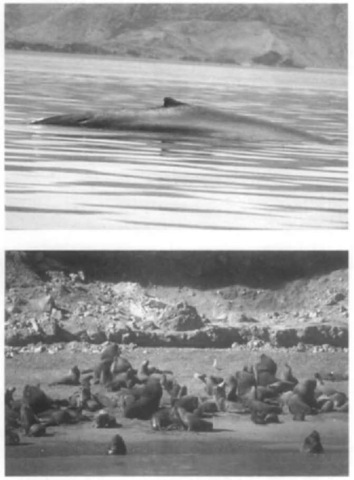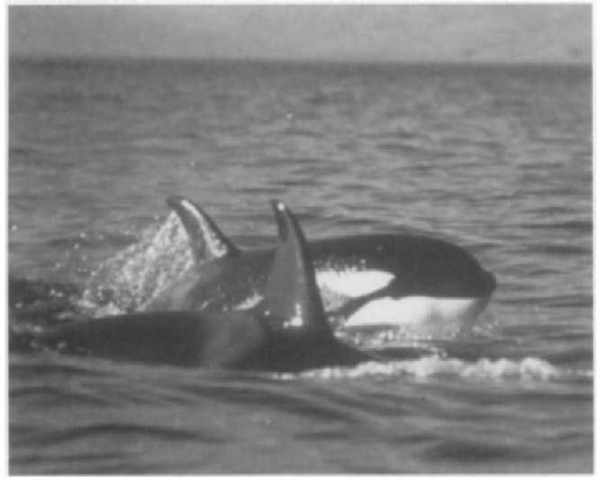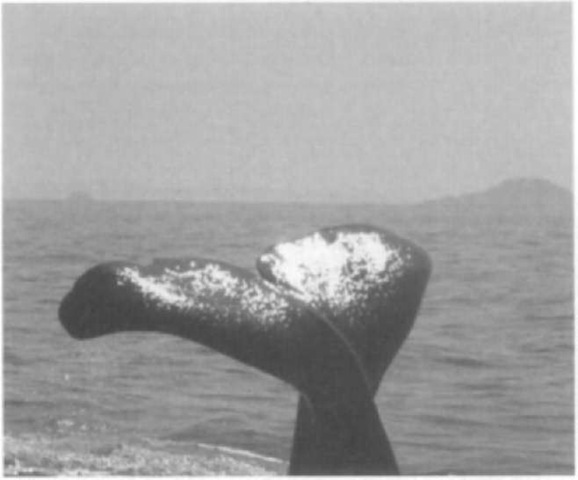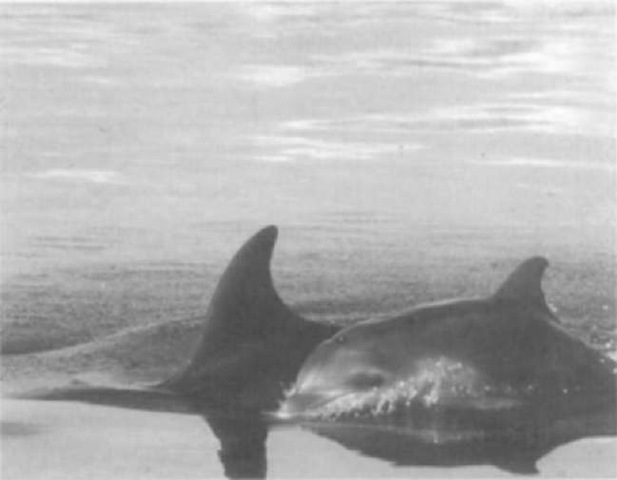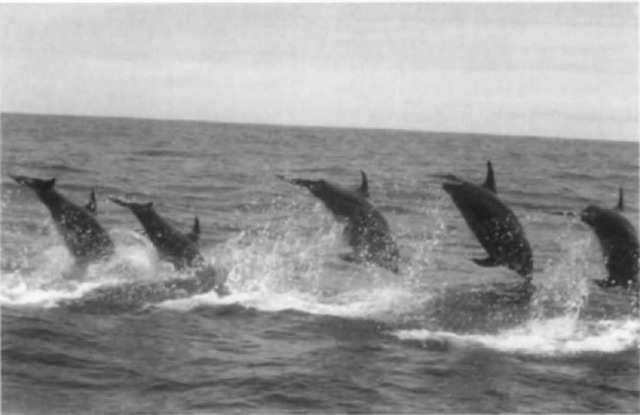Many animals spend part or all of their lives in groups. A group may be viewed as any set oi individuals, belonging to the same species, which remain together for a period of time interacting with one another to a distinctly greater degree than with other conspecifics. Thus, the study of group living is the study of social behavior, and marine mammals societies can be remarkably diverse (Fig. 1).
Groups can be classified based both 011 the amount oi time individuals interact with each other and 011 the benefits that individuals receive. Schools last for periods oi minutes to hours whereas groups last months to decades. Aggregations (or non-mutualistic groups) do not provide a larger benefit to individuals than if they were alone, whereas groups (or mutualistic groups) do provide such a benefit to their members. Aggregations are formed because a nonsocial iactor, e.g., food, attracts individuals to the same place, and groups are formed because they provide a benefit to their members.
Figure 1 (Top) Blue whales are usually found alone or in small numbers. Photo by B. Tershy. (Bottom) South American sea lions aggregate in large numbers during the breeding season.
I. Group Living
There appear to be three conditions under which group living will evolve: the benefits to the individual outweigh the costs, the costs outweigh the benefits but strong ecological constraints prevent dispersal from the natal territory, and the area where the group lives can accommodate additional individuals at no cost.
A. Benefits and Costs of Group Living
Group living is explained in terms of benefits to the individual group members—direct fitness, kin selection, reciprocity, and mutualism—and to the groups themselves—group selection. Kin selection and reciprocity are perhaps the arguments employed most frequently to explain benefits of group living. For instance, kin selection explains the generalities of cooperative breeding in mammals and birds and the evolution oi cooperation among male chimpanzees. However, these traditional explanations are, in some cases, inadequate and some behaviors are best explained in terms of direct fitness. Delayed direct benefits to the subordinate male explain the occurrence of dual-male courtship displays in long-tailed manaldns, and direct benefits from the early detection of danger explain the sentinel behavior of meerkats.
Reduction of predation and increase of foraging efficiency and the number of individuals that can be supported by the available local resources have been typically viewed as important factors shaping group living. However, the reduction of predation and increased foraging efficiency can be accomplished through a myriad of different mechanisms (Table I). In addition, these two benefits are sometimes inadequate to explain group living: in African lions, female-grouping patterns are best explained as facilitating the cooperative defense of cubs against in-fanticidal males and the defense of territory against other females, not as increasing foraging efficiency. Group living can also impose several costs to individuals (Table II). The magnitude of these costs may be important in shaping group living; it has been suggested that differences in group size between primate and carnivore species may be related to the differences in their costs of locomotion. Marine mammals reduce the costs of locomotion bv developing energy-conserving swimming behaviors such as routine transit speeds, wave riding, porpoising, and gliding. It has been hypothesized that this reduced cost of locomotion, coupled with a lack of restriction to a particular territory, has allowed some populations of killer whales (Orcinus orca), and possibly long-finned pilot whales (Globicephala melas), to develop societies in which females and males remain with their natal group for life (Fig. 2). I11 this manner, males traveling with their mothers can have large home ranges and thus find potential mates.
Studies have documented novel strategies followed by individuals living in groups, including the complexity of intra- and intergroup interactions. Female African lions cooperate to defend their territory from intruders; however, some individuals consistently lead the approach, whereas other individuals lag behind without being punished by the leaders. One potential explanation for this tolerance is that females need to defend their territories against other groups and their success depends in part on the number of defending females, even if some individuals
TABLE 1 Benefits of Group Living
Reduction of predation
Enhanced ability to detect predators: sensory integration” Enhanced ability to deter predators, even larger than group members” Enhanced ability to escape, including predator confusion and coordinated evasion behavior” Reduced individual probability of being selected as prey By associating with conspecifics: dilution effect” By hiding behind conspecifics: selfish herd”
Allocation of time to other activities Reduced individual vigilance time Because of group vigilance (many eyes)” Because of decreased individual predation risk” Increased foraging time for mothers by having babysitters”
Enhanced detection and capture of prey Foraging in risky, but profitable, areas-
Finding prey or reducing variation in food intake through cooperative searching: sensory integration” Following more knowledgeable animals in the group to a food source: information transfer” Following other species with more specialized senses to a food source”
Joining resources uncovered by others, also known as conspecific attraction, kleptoparasitism, area copying, scrounging, or tolerated theft” Acquisition of innovative feeding behaviors from another group member Social learning through social facilitation (contagion of motivational states) Directing attention to particular locations or objects: local enhancement Imitation of knowledgeable tutors” Information sharing and cultural transmission” Increased diversity and size of prey that is captured Due to more individuals foraging” Due to prey flushed by movements of group members”
Due to individuals with different skills or abilities foraging together: skill pool effect Increased food intake as a result of communal foraging” Lower risks of injury while hunting’
Acquisition or defense of resources
Large groups defend, occupy, or displace small groups from better territories
Large groups acquire or defend localized food sources, including carcasses, from conspecifics or other species”
Improved reproduction
Caring and protection of offspring Learning to be a parent” Finding mates in isolated or vast areas” Enhanced reproductive synchrony”
Enhanced survival when there is prevention of dispersal to neighboring territories Males benefit from cooperative displays, subdominant males receive the payoff later in time Males in large groups gain access to females”
Reduction of parasitism
When number of hosts in a group increases more rapidly than the number of mobile parasites, reduced individual probability of being parasitized by associating with conspecifics: dilution effect
Other
Huddling to survive cold temperatures” “Suggested or documented benefits in marine mammals. Never lead the charge. Complex social behaviors have also been reported in marine mammals. In a breeding colony of gray seals (Halichoerus grypus) at the island of North Rona, Scotland, a few large males monopolize matings on the breeding beaches; however, females over the years give birth to full siblings not sired by the dominant male. Fathers of the pups are nondomi-nant males that mate with the same females in different seasons. Thus behavioral polygyny and genetic fidelity seem to operate simultaneously in this colony. It has been suggested that this strategy of partner fidelity is maintained in the population because it may diminish aggressive interactions between dominant males and thus reduce the pup mortality originated by these clashes. Male Indian Ocean bottlenose dolphins (Tursiops aduncus) in Shark Bay, Australia, exhibit very complex levels of alliances that are only matched by humans. Males form strong and stable bonds for over 10 years with one or two other males, and males
TABLE 11 Costs of Group Living
Increased predation
Large groups more attractive to predators
Larger groups more likely to be detected by a predator: encounter effect
Reduced foraging efficiency
Increased amount of food needed for group”
Increased energy spent, distance traveled, or area covered to find food for group” Increased conspicuousness: prey able to detect predators sooner than if predators are alone
Reduction in food intake due to sharing of prey scramble competition, scrounging, and individual discrepancies in foraging success Reduction in food intake due to interference by the behavior of other individuals” Reduce ability to learn innovative foraging skills due to scroungers in the group in these first-order alliances cooperate to form aggressively maintained consortships with individual females. Each first-order alliance forms moderately strong bonds with one or two other alliances (these second-order alliances do not endure for more than a few years) and males cooperate to take or defend females from other alliances. A different strategy is for ‘males to form a large but loose superalliance that competes with the smaller and more stable first-order or second-order alliances. Members of the superalliance split into smaller alliances of pairs and trios that are constantly changing but that are always composed of males from the superalliance. These pairs and trios join conflicts involving members of the superalliance and are always victorious. It is hypothesized that the large size of the superalliance allows individuals to compete with the smaller alliances and that the fluidity of individual associations within the superalliance allows males to maintain affiliative bonds.
Increased conflicts for resources due to the presence of more conspecifis or other species Individuals from other groups or species following: social parasitism” Individuals from other groups or species attracted to feeding parties: local enhancement”
Reduced reproduction, increased competition for mates or other limited resources Individual discrepancies in number or quality of mates obtained” Extrapair copulations and loss of fertilizations to other members of group” Increased intraspecific competition for limited resources” Increased infant mortality”
Increased risk of exploitation of parental care by conspecifics Theft of nest material
Increased risk of infection
Increased contagious parasitism Increased disease transmission
“Suggested or documented costs in marine mammals.
Figure 2 In certain populations, male and female killer whales renuiin with their natal groups throughout their lifetime.
B. Female Social Behavior
One previously neglected area of research is the study of female social behavior. Because females and males frequently have different interests, female relationships are important in understanding social evolution independently of the behavior of males. For instance, dominant female chimpanzees have a higher reproductive success than subordinate ones, apparently because they are able to establish and maintain access to good foraging areas, competing in extreme cases as intensely as males. Females may also influence behaviors that affect the interests of males. Female bird song appears to have evolved in part to compete for males; however, this behavior has the potential consequence of preventing polygyny by deterring rival females.
The study of females is also essential to understand group living in marine mammals. Captive female common bottlenose dolphins (Tursiops truncatus) maintain dominance hierarchies and also compete aggressively against each other. However, unlike chimpanzees, it is unknown if female dominance hierarchies in free-ranging dolphins translate into differences in reproductive success. The preference and fidelity of female gray seals at North Rona toward nondoininant males undermine the polygynous strategy of dominant males and result in a different mating system from that inferred by behavioral observations. The large number of females in colonies of certain pinnipeds, such as elephant seals (Mirounga spp.), has permitted the existence of alloparenting and the appearance of a distinct suckling strategy by calves: milk stealing. Male and female sperm whales (Phtjseter macrocephalus) have different grouping strategies: females aggregate in complex groups whereas adult males are less social. The function of the female groups is to provide care for calves that are too young to follow their mothers during their deep foraging dives (Fig. 3). It has been suggested that alloparenting in sperm whales reduces the period in which the calf is unaccompanied and thus provides protection from predators and also perhaps provides communal nursing. Thus key features of the sperm whale society are explained solely by the behavior of females.
II. Social Behavior of Marine Mammals
There are several differences between terrestrial and marine environments that have allowed the evolution of distinctive strategies in marine mammals. Drag, heat loss, and density of the water generate differences in scaling and costs of locomotion, allowing many marine mammals to have large body sizes and large home ranges. Sound is the form of energy that best propagates in water and, not surprisingly, marine mammals employ it for social communication and many species employ echolocation to navigate. Marine mammals must find food that is for the most part dispersed and patchy, thus they appear to have no territories outside of the breeding season. Due to the global effects of the atmosphere and the ocean in the marine environment, marine mammals are affected by both global and local processes as exemplified by the impact of El Nino-Southern Oscillation events on different populations.
Figure 3 Alloparenting behavior apparently allows sperm whale mothers to make deep foraging dives.
A. General Strategies
Sirenians, sea otters (Enhydra lutris), and polar bears (Ur-sus maritimus) are solitary animals that have few social interactions beyond mating and mother/offspring pairs. The time that these pairs remain together is 1 to 1.5 years in sirenians, 5 to 7 months in sea otters, 2.5 years in polar bears. When a female becomes receptive, sirenians form aggregations that have as many as 17 males physically competing for access to the female or defending display territories. During the breeding season, male sea otters establish territories that include the areas occupied by several females, whereas male polar bears mate with only one partner because females have a dispersed distribution.
Most pinnipeds aggregate in colonies during the breeding season. A major factor influencing the size of these colonies is the distribution of habitat available for parturition. All pinnipeds give birth out of the water and thus the areas favored for parturition are oceanic islands, ice, or isolated mainland regions not easily accessible to terrestrial predators. When available space is limited, females become densely aggregated in large colonies that favor mating systems in which males defend either aggregations of females or areas occupied by females, or aggregate and display before aggregations of females (Fig. 4). When parturition space is dispersed, females are isolated, males usually have access to only one female, and no colonies are formed. The strongest association found in pinnipeds is formed by a mother and her offspring and lasts from less than 1 week to almost 3 years, depending on the species. Pinnipeds haul out together outside of the breeding season. Although this nonreproductive social behavior is poorly known, evidence shows that it increases vigilance for predators in harbor seals (Phoca vittdina). It is believed that hauling out together also allows pinnipeds to rest, avoid predators, molt, or warm themselves. For instance, walruses (Odobenus rosmarus) in large numbers may decrease the rate of body heat loss, particularly in calves, when on land or ice.
Figure 4 Pinniped males are able to monopolize access to clustered females during the breeding season.
The complexity of cetacean societies appears to be related to the amount of time invested in lactating and in rearing the calf after weaning. Baleen whales are found in schools of varying size, from single individuals to more than 20 whales. Pairs of mothers and their offspring form stable associations that last less than 1 year. It is currently unclear if long-term associations exist among adult whales. Most females give birth every 2 to 3 years and have the potential to produce more than 20 calves throughout their lifetime. Schools of baleen whales have been observed in both feeding and breeding grounds. For instance, feeding humpback whales (Megaptera novaean-gliae) forage alone, in aggregations, or as a group, depending on prey type, whereas aggregations of breeding males display acoustically or compete directly for access to females. Odontocetes are the most social marine mammals and have different types of societies as suggested by the large variation in school size among species (Table III). Short-term associations between adults characterize several porpoises (Phocoenidae). Associations between mothers and their offspring last 8 to 12 months. Females breed every 1 or 2 years and may give birth to 15 calves or more during their life span. In medium-sized delphinids, such as bottlenose dolphins, associations between adults are varied: they last a short amount of time in some individuals and several years in others; long-term associations appear to be common between males in certain populations. Calves remain with their mothers 2 to 11 years (Fig. 5). Females give birth at least every 3 years and may produce close to 10 calves throughout their lifetime. Baird’s beaked whales (Berardius bairdii) apparently employ a novel social strategy. Males live longer than females and thus there is an excess of mature males over females. It has been hypothesized that these traits indicate a society in which males provide significant parental care by rearing weaned calves: protecting them from predators and teaching them foraging skills. In the case of the sperm whale and large-sized delphinids (pilot whales, Globieephala spp., and some populations of killer whales), females appear to spend their entire lives within their natal group, forming strong matrilineal societies. Females usually breed every 3 to 6 years and may give birth to about 5 calves throughout their lifetime, more in the case of long-finned pilot whales. Females may live over 20 years past their reproductive years. It has been suggested that this strategy allows old females to transmit and store cultural information and provide alloparental behavior. In the case of short-finned pilot whales (G. macrorhynchus), it is possible that nonreproductive females even provide alloparental nursing. Male killer whales in some populations, and perhaps male long-finned pilot whales, remain in their natal group for life but mate with females from other groups when they meet. Male sperm whales, and perhaps male short-finned pilot whales, leave their nursing group when they reach puberty; however, the former, after they have reached their late 20s, roam among nursery groups looking for mates, whereas the latter appear to join other nursery groups. It has been suggested that adult male short-finned pilot whales remain in the nursery group that they join and engage in few clashes with other males because they are able to engage in nonreproductive mating with old females, as apparently occurs in bonobos. A recent hypothesis that remains to be tested suggests that the cultural transmission of behaviors, i.e., learned behaviors passed onto family members, is being conserved within matrilineal groups of odontocetes, affecting the course of genetic evolution. This modification of the course of genetic evolution through culture has thus far been documented only in humans.
TABLE III School Sizes of Odontocetes
|
Species” |
Average school size |
Maximum school size |
|
Phocoenoides dalli (7) |
2.3-7.4 |
5-500 |
|
Neophocaena phocoenoides (1) |
2.0 |
13 |
|
Phocoena phocoena (6) |
1.2-5.7 |
15-100 |
|
P. sinus (1) |
1.9 |
7 |
|
P. spinipinnis (1) |
4.5 |
10 |
|
Cephalorhynchus commersonii (1) |
6.9 |
110 |
|
Lissodelphis borealis (2) |
9.9-110.2 |
60-2000 |
|
Delphinus sp. (4) |
46.8-385.9 |
650-4000 |
|
Grampus griseus (9) |
6.3-63 |
20-500 |
|
Lagenodelphis hosei (1) |
394.9 |
1500 |
|
Lagenorhynchus acutus (1) |
53.2 |
? |
|
L. obliquidens (3) |
10.8-88 |
50-6000 |
|
L. obscurus (3) |
9.5-86 |
24-1000 |
|
Sot alia fluviatilis (1) |
2.5 |
10 |
|
Sousa plumbea (1) |
6.6 |
25 |
|
Stenella attenuata (5) |
26.0-360.0 |
148-2400 |
|
S. clymene (1) |
41.6 |
100 |
|
S. coeruleoalba (3) |
60.9-302 |
500-2136 |
|
S. frontalis (2) |
6.0-10.0 |
50-65 |
|
S. longirostris (4) |
37.6-134.1 |
95-1700 |
|
Steno bredanensis (2) |
14.7^10.0 |
53 |
|
Tursiops aduncus (2) |
10.2-140.3 |
80-1000 |
|
T. truncatus (29) |
3.1-92.0 |
18-5000 |
|
Feresa attenuata (1) |
27.9 |
70 |
|
Globieephala macrorhynchus (2) |
12.2-41.1 |
33-230 |
|
G. melas (3) |
9.3-84.5 |
220 |
|
Orcinus orca (10) |
2.6-12.0 |
5-100 |
|
Pseudorca crassidens (1) |
18 |
89 |
|
Peponocephala electra (2) |
135.3-199.1 |
400 |
|
Delphinapterus leucas (3) |
3.8-32.9 |
100-500 |
|
Monodon monoceros (1) |
3 |
50 |
|
lnia geoffrensis (2) |
1.6-2.0 |
8-10 |
|
Lipotes vexillifer (1) |
3.4 |
10 |
|
Platanista gangetica (1) |
1.4 |
3 |
|
Kogia sima (1) |
1.7 |
? |
|
Physeter macrocephalus (6) |
3.7-22.1 |
17-120 |
|
Berardius bairdii (1) |
7.2 |
25 |
|
Ziphius cavirostris (1) |
2.3 |
7 |
“Values in parentheses indicate number of studies.
Figure 5 Bottlenose dolphin calves remain with their mothers for up to 11 years.
B. Foraging
Increased foraging efficiency is considered to be one of the principal roles of group living in cetaceans. However, thus far transient killer whales provide the only clear example supporting the argument that marine mammals live in groups because of foraging benefits. Transient killer whales live in the Pacific
Northwest and prey on harbor seals and other small marine mammals. Individuals maximize their caloric intake if they feed in groups of three, which is the size of the group in which they live. The small size of these groups is apparently maintained by the departure of all female offspring and all but one male offspring from their natal group.
Two benefits of group living through foraging efficiency are the ability to search for prey as a group and to forage communally (Fig. 6). Searching for prey as a group allows individuals to combine their sensor)’ efforts, which should be an advantage when prey has a dispersed and patchy distribution. Communal foraging allows individuals to combine efforts to pursue and capture prey. This behavior has been reported in dolphins, baleen whales, including fin whales (Balaenoptera physalus) and bowhead whales (Balaena mysticetus), and pinnipeds, such as fur seals and sea lions. However, in some instances it is unclear whether individuals combine efforts to pursue and capture prey or merely aggregate in an area where food is concentrated. A particular type of communal foraging behavior, termed prey herding, has been observed when feeding on shoaling fish. Individuals encircle shoals offish and thus create a tight, motionless ball of prey from which they can grab individual fish; in some cases, individuals release bubbles to further tighten the ball of prey. This herding of prey has been well described in humpback whales, dusky dolphins (Lagenorhynchus obscurus), and killer whales. However, it has also been reported in other species, such as bottlenose dolphins, common dolphins (Delphinus spp.), Clv-mene dolphins (Stenella clymene), and Atlantic spotted dolphins (S. frontalis). It is difficult to document this behavior, and only one study has quantified the success of cetaceans in herding prey. This study noted that common bottlenose dolphins off Costa Rica seldom herd prey into a ball when it is scattered, rather they pursue the individual fish. Perhaps evasive maneuvers of prey or interference by hunters from other species feeding on the same prey prevents dolphins from herding.
Figure 6 Communal foraging allows dolphins to combine pursuing efforts.
C. Predation
The reduction of predation is considered to be another principal function of group living in cetaceans. Certain shark species and some large delphinids attack cetaceans, and calves suffer higher mortality than adults. However, pinnipeds apparently also form groups in response to predation. Walruses sometimes form groups lasting throughout the year in the water and on haul-out sites. It has been suggested that this may be a female strategy for pup defense against predation by polar bears.
Thus far no conclusive evidence shows that group living in cetaceans is driven because of benefits in reduction of predation, although it has been suggested that this could be the case in sperm whales. Nonetheless, group living may provide several benefits to reduce predation. Groups are able to mob and chase away predators, as has been observed in humpbacked dolphins (Sousa spp.) when attacked by a shark. It is believed that other dolphins also employ this antipredatory strategy. Sperm whales, and perhaps humpback whales, employ the marguerite formation, in which adults surround young individuals by having their heads toward the center (horizontal formation) or toward the surface (vertical formation). Adults have their flukes toward the periphery and employ them to slap at predators, which in the majority of observations have been killer whales.
Group living appears to be related to food and predation in terrestrial and marine mammals. Thus it has been argued that the variation of group sizes among dolphin species is related to food availability, to prey habitat, or to the need to defend against predators. Data have been compiled on the average school size from 24 species of the family Delphinidae (Table III). Because definitions of school vary among researchers, the author has attempted to make values comparable by selecting only studies with at least 30 observations throughout a season and defined schools as the number of individuals engaged in similar activities regardless of distance between them. The author averaged the values from species belonging to the same genus and related them to crude measures of predation pressure and prey habitat, measures obtained from the literature. Results indicate that regardless of the body weight of the species, average school sizes are larger when predation pressure is high rather than low and when prey is found in open rather than in enclosed waters (Fig. 7). School sizes are largest when both pressure from predators is high and prey lives at depth in oceanic waters. Thus it appears that the average school size of dolphins is related both to the predation they experience and to the habitat where their prey lives. In turn, reproductive success might also be related to these two environmental factors. The reproductive success of female bottlenose dolphins is highest in shallow waters, either because calves and their mothers are able to detect and avoid predators or because prey density is highest.
Figure 7 Relationship among predation pressure, prey habitat, and average school size of 16 genera of the family Delphinidae. Open circles indicate small species (females weigh less than 150 kg) and solid circles indicate large species (females iveigh more than 150 kg).
III. Conclusion
Group living involves benefits and costs, and the resultant society represents a balance between the different interests of all group members. The aquatic environment has allowed marine mammals to pursue complex and sometimes unique social strategies. At the same time, the basic needs of finding food, ensuring reproduction, and evading predators are also found in terrestrial environments. This convergence provides interesting parallels between the social strategies of marine mammals and those of terrestrial mammals: chimpanzees and bottlenose dolphins, elephants and sperm whales. Although many questions about the group behavior of marine mammals remain unanswered, long-term studies and research on poorly known species will provide a more profound understanding of their societies.
